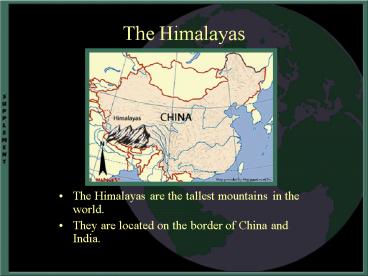The Himalayas - PowerPoint PPT Presentation
1 / 14
Title: The Himalayas
1
The Himalayas
- The Himalayas are the tallest mountains in the
world. - They are located on the border of China and
India.
2
What do you think?
- How were the Himalayas formed?
- Why are the Himalayas the tallest mountains in
the world?
3
In this activity you will
- Learn of the different ways that mountains form.
- Learn why the Himalayas are so tall.
4
Plate Tectonics
Eurasian Plate
Plates
Indian Plate
- The earths crust is split into several plates.
- These plates float on top of magma (a hot, thick,
gel-like substance). - When currents inside the earth move the magma,
the plates move too. - This movement sometimes causes mountains to form.
5
Just Checking
- The earths crust is split into __________.
- The hot, thick, gel-like substance found within
the earth is called ___________.
6
There are 4 types of mountains
- Volcanic Mountains
- Erosional Mountains
- Fault-block Mountains
- Folded Mountains
7
Volcanic Mountains
- Volcanoes form when magma within the earth pushes
its way up through the crust. - While pushing through the crust, the pressure
causes the surrounding crust to rise, forming a
mountain. - Magma is deposited on the surface, sometimes
creating a cone shaped mountain.
8
Erosional Mountains
- Erosional mountains form when wind or water wear
down some materials on the earths surface,
leaving other materials behind. - Some materials erode faster than others. In the
picture above, some of the rock material eroded
much faster than the other material. The brown
rock material left behind forms a mountain.
9
Fault-block Mountains
Fault
- Fault-block mountains form when rock layers break
and form a fault line. - As the two blocks are being pushed together, the
pressure forces one block up and the other block
down. - The block that is forced upward forms a mountain.
10
Folded Mountains
- Folded mountains form as two plates move toward
each other. - The plates push against each other causing the
crust to fold or ripple - This is like when you push 2 ends of a piece of
paper together and the middle bends or folds.
11
Just Checking
- Mountains that form when magma within the earth
pushes its way up through the crust. __________ - Mountains that form when wind or water wear down
some materials on the earths surface, leaving
other materials behind. ____________ - Mountains that form when a plate cracks and forms
a fault line. ______________ - Mountains that form when plates push up against
each other causing the crust to fold or ripple.
______________
12
Himalayas
- The Himalayas formed as a result of the Indian
Plate and the Eurasian Plate moving toward one
another. - When two plates run into each other, they will do
one of the following - If one plate is denser (heavier) than the other,
it will sink below the other plate - If both plates have the same density, they will
continue to push against one another resulting in
folded mountains. -
-
Same - Density
Denser plate
13
The Himalayas
- Both of these plates are the same density.
- As the plates keep pushing against each other,
there is no place for the crust to go except bend
upwards. - The plates are still running into each other and
the Himalayas are growing by more than 1 cm each
year.
Himalayas
Indian Plate
Eurasian Plate
14
Just Checking
- The Himalayas are ___________ mountains.
- The Himalayas are the result of what two plates
running into each other? - ________________ and _______________
- Neither of these two plates is sinking because
they are both the same ___________. - The Himalayas are still growing at a rate of
___________ each year.

